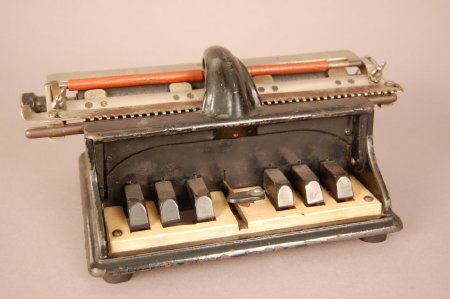Object ID:
1990.18.1
Title:
Hall Braille Writer
Creator:
Hall, Frank, inventor
Description:
Black enameled steel frame resting on four rubber feet, stenciled in gold on steel bar above keyboard, "The Hall Braille Writer"; arched steel bar extends backwards from the front top of the frame to the upward writing steel embossing head protruding through a slot in the carriage; keyboard has six black-enameled wooden keys with beveled fronts, oval black rubber space key is mounted in the middle of the keyboard, projecting above and slightly forward of the dot keys, all keys are housed in a yellow celluloid-covered wooden keyboard shield bolted to the frame, with a black enameled tinplate backplate; nickel-plated steel carriage with black hard rubber platen and smaller red rubber-covered steel paper roller, black wooden platen knobs on left (right is missing); three brackets that secure the paper roller secured with non-original wing nuts; four rolled steel paper storage bars bolted under carriage; toothed nickel-plated carriage release bar is mounted on front of carriage; no serial number; brass carriage return bell screwed under carriage on right; tension for carriage provided by a spring-loaded pulley secured to back of frame under carriage, attached to carriage with cotton cord.
Dimensions:
H-15 W-35 D-22 cm
Date:
ca. 1905
Made by:
Harrison & Seifried
Place of Origin:
Chicago, IL
Provenance:
The first prototype for the Hall Braille Writer was conceived by Frank Hall, Superintendent of the Illinois School for the Blind in 1892. It was created by a local gunsmith and machinist, Gustave Seiber. Hall took the prototype to the Munson Typewriter Company in Chicago, where Superintendent T.B. Harrison and designer Samuel J. Seifreid created six pilot models, delivering them to Hall on May 27th, 1892. Munson Typewriter also made an additional lot of 94 machines for Hall. Harrison and Seifried soon left Munson and began manufacturing the braillewriter full time, along with the Hall Stereotyper and later a tactile mapmaking machine. When the partnership dissolved, Samuel Seifried continued the business until his death in 1912. The Cooper Manufacturing Company took over the braillewriter. When M.B. Skinner bought Cooper in 1921, the Hall Braille Writer was re-designed and continued to be sold until Cooper sold the design, dies, and tools to the American Foundation for the Blind around 1930. AFB assembled a few additional machines from parts in stock, but at the same time was developing its own machine, the Foundation Writer.
